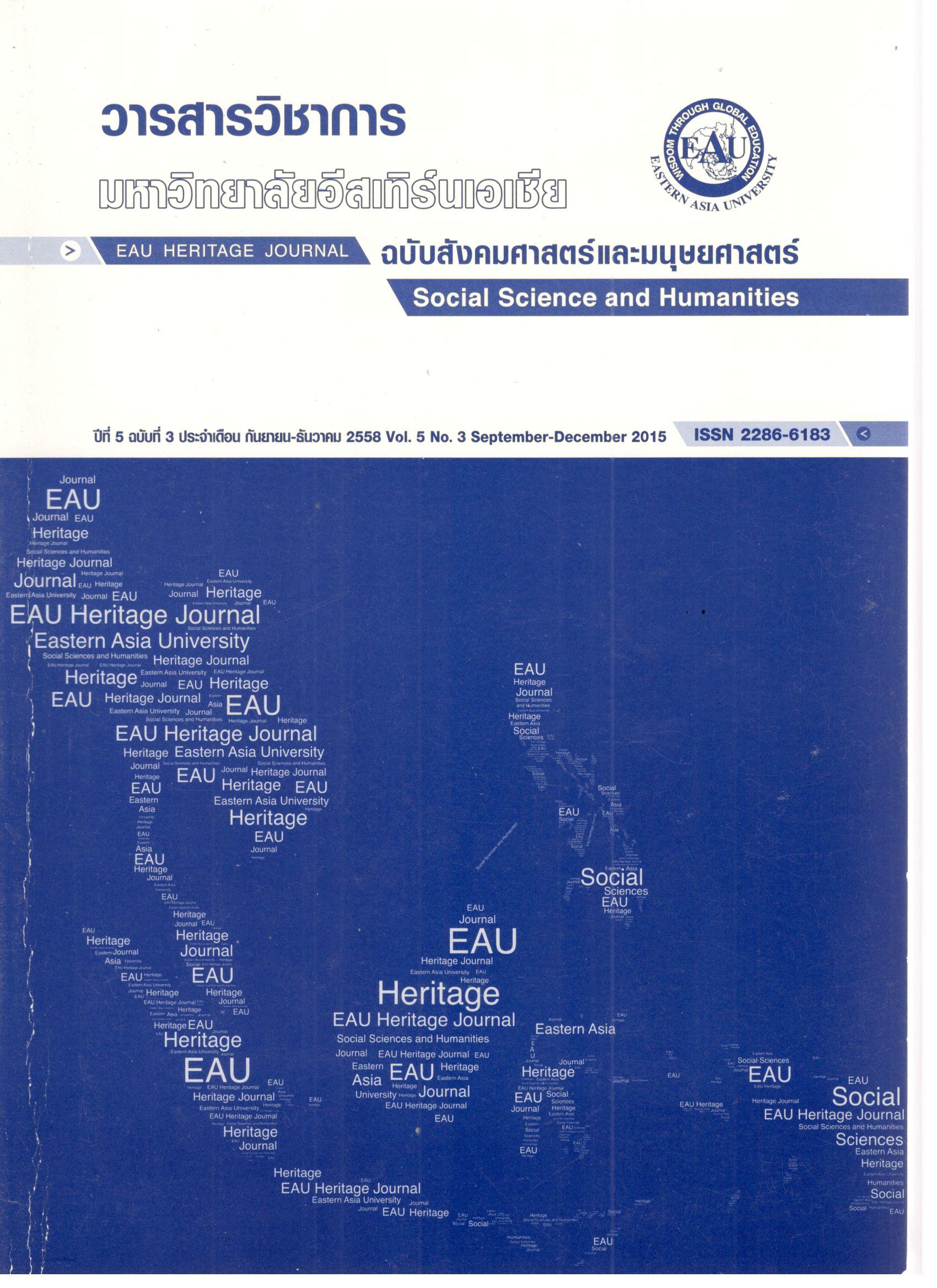การวิเคราะห์ระบบการจัดการภัยพิบัติในภาครัฐ ภาคประชาสังคม และองค์การระหว่างประเทศ: กรณีของไต้หวัน
Keywords:
ไต้หวัน, ธรรมชาติ, ภัยพิบัติAbstract
ไต้หวันได้เผชิญหน้ากับภัยพิบัติทางธรรมชาติจำนวนมากเนื่องจากสภาพแวดล้อมทางภูมิศาสตร์และธรณีวิทยามีลักษณะเฉพาะ รวมทั้งมีการใช้ประโยชน์จากธรรมชาติมากเกินไป จึงทำให้เกิดมลภาวะและการเปลี่ยนแปลงสภาพภูมิอากาศของโลกทำให้มีภัยพิบัติที่รุนแรงมากขึ้นอย่างมีนัยสำคัญที่ก่อให้เกิดการสูญเสียชีวิตและทรัพย์สิน นอกเหนือจากรัฐบาลแล้ว ผู้มีบทบาทในการจัดการภัยพิบัติที่สำคัญ คือ องค์การระหว่างประเทศและภาคประชาสังคมของไต้หวัน อย่างไรก็ตาม ระดับของการมีส่วนร่วมของตัวแสดงแต่ละตัวและบทบาทความเป็นผู้นำจะขึ้นอยู่กับสภาพความเป็นจริงทางการเมือง การศึกษาครั้งนี้พยายามประเมินการจัดการภัยพิบัติในไต้หวันในสามด้าน คือ (1) การทำความเข้าใจเรื่องความสัมพันธ์ระหว่างสิ่งแวดล้อมและการจัดการภัยพิบัติ, (2) การใช้ เหตุการณ์แผ่นดินไหวที่เกิดขึ้นเมื่อวันที่ 9 กันยายน ค.ศ. 1999 และพายุไต้ฝุ่นมรกตเป็นตัวอย่างในการประเมินระบบการจัดการ, และ (3) การมีปฏิสัมพันธ์ระหว่างผู้มีบทบาทในการจัดการภัยพิบัติ ผลการศึกษาพบว่าระบบการจัดการภัยพิบัติในไต้หวันมีความโดดเด่นด้วยระบบราชการแบบ Hydra-headed และ เนื่องจากการสื่อสารที่ไม่มีประสิทธิภาพระหว่างรัฐบาลกลาง รัฐบาลท้องถิ่นและองค์กรพัฒนาเอกชนขาดประสิทธิภาพ จึงทำให้องค์กรผู้มีส่วนร่วมในการจัดการช่วยเหลืออยู่ในลักษณะต่างคนต่างทำ จึงส่งผลให้สูญเสียกำลังคนและการแบ่งปันทรัพยากรอย่างมีประสิทธิภาพ ดังนั้น รัฐบาลควรเรียนรู้จากประสบการณ์ขององค์กรพัฒนาเอกชนที่ใช้การเชื่อมโยงแบบแนวนอน การรวมข้อมูลการช่วยเหลือทั้งแบบแนวตั้งและแนวนอนเพื่อที่จะทำให้มีการใช้ทรัพยากรที่มีประสิทธิภาพมากขึ้น
References
Birkland, T. A. (2006). Lessons of disaster: Policy change after catastrophic events. Washington, DC: Georgetown University.
Bryner, G. C., (2002). Assesseing claims of environmental justice: conceptual frameworks. In K. M. Mutz, G. C. Bryner, & D. S. Kenney (Eds.), Justice and natural resources: Concepts, strategies, and applications (pp. 31-56). Washington, DC: Island.
Chen, S. H., Chang, C. C., Li, H. C., Yang, H. H., Deng, C. Z., Lee, S. C., & Lee, Y. N. (2010). Social impacts and recovery survey of typhoon Morakot. (NCDR 99-T36). Taipei, Taiwan: National Science and Technology Center.
Chiang, M. H., Chen, C. C., Lin, H. S., Liu, Y. H., & Chu, C. Y. (2012, May). Operation and problem of disaster management mechanism in Taiwan. TASPAA, Symposium conducted at NCKU, Taiwan.
Gibbon, P., Bair, J., & Ponte, S. (2008). Governing global value chains: An introduction. Economy and Society, 37(3), 315-38.
Gibbon, P., Bair, J., & Ponte, S. (2008). Global value chains: From governance to governmentality. Economy and Society, 37(3), 365-92.
Hajer, M., & Wagenaar, H. (2003). Deliberative policy analysis: Understanding governance in a network society. UK: Cambridge University.
Huang, C. E. (2000). Human activities intensify natural disasters. Environmental Education Quarterly, 41, 49-56.
Hung, H. C. (2007). Governmental recovery resource allocation decision following natural disasters: A case study of the 921 Chi-Chi earthquake. Journal of Public Administration, 23, 95-124.
Ireni-Saban, L. (2013). Challenging disaster administration: Toward community-based disaster resilience. Administration & Society, 45(6), 651-73.
Kirmayer, L. J., Sedhev, M. R., Dandeneau, W. S., & Isaac, C. (2009). Community resilience: Models, metaphors and measures. Journal of Aboriginal Health, 7(1), 62-117.
Kuo, J. K., Chang, C. J., & Shen, Y. C. (2012). Post-disaster community reconstruction system: Analysis of 921 earthquake and typhoon Morakot. Chinese Local Autonomy, 65(10), 21-46.
Lin, M. G., & Zhan, J. H. (2010). NGOs participation in disaster relief and relevant management: Cases study of Wenchuan earthquake and Taiwan 921 Earthquake. Chinese Public Administration, 297, 98-103.
Lin, T. H. (2012). The politics of reconstruction: A comparative study of earthquake relief efforts in China and Taiwan. Taiwanese Journal of Sociology, 50, 57-110.
Lin, W. I., Zheng, R. J., Yang, W. H., & Lin, J. J., (2013, Oct). The establishment of survivor displacement and community reconstructing service system after disasters. In Typhoon Morakot Reconstruction Issues and Reflection International Conference, Symposium conducted at Kaohsiung, Taiwan.
Liu, L. W., Chiou, Y. C., & Lu, W. P. (2003). Inter-organizational coordination for disaster relief in the 9-21 earthquake of Taiwan. The Chinese Public Administration Review, 12(3), 139-78.
Lu, J. C., Chen, S. Y., Chang, C. L., Li, Y. N., & Chuang, M. J. (2010). Analyses of recovery issues and policies after typhoon Morakot (NCDR 99-T36). Taipei, Taiwan: National Science and Technology Center.
North, D. C. (1990). Institutions, institutional change and economic performance. New York: Cambridge University Press.
Pearce, L. (2003). Disaster management and community planning, and public participation: How to achieve sustainable hazard mitigation. Natural Hazards, 28, 211-28.
Shieh, J. C., Chen, J. S., & Lin, W. I. (2013). Skip to permanence without transition? Policy-making in post-Morakot reconstruction. Taiwan: A Radical Quarterly in Social Studies, 93, 49-86.
Summer. (2009). Three deficiency of rebuild regulations. Retrieved from http://www.coolloud.org.tw/node/45179
Taiwan Indigenous Peoples Portal. (2009). Ignoring the victims’ opposition, reconstruction regulations was forced pass. Retrieved from http://www.tipp.org.tw/news_article.asp?N_ID=13396
Tang, C. P. (2001). Disasters, bureaucracy, and democracy: Political and institutional analysis of governmental response to Chi-Chi earthquake of 1999. The Chinese Public Administration Review, 11(1), 67-98.
UNIC. (2015). UNIC and non governmental organizations (NGOs). Retrieved from http://unic.org.pk/index.php? id=ngo
UNISDR. (2015). Terminology. Retrieved from http://www.unisdr.org/we/inform/ terminology
Vale, L. J., & Campanella, T. J. (Ed.). (2005). The resilient city: How modern cities Recover from disaster. New York: Oxford University.
Wang, L. R., Chen, S., & Chen, J. (2013). Community resilience after disaster in Taiwan: A case study of Jialan village with the strengths perspective. Journal of Social Work in Disability and Rehabilitation, 12, 84-101.
Wisner, B., Blaikie, P., Cannon, T., & Davis, I., (2004). At risk: Natural hazards, people’s vulnerability and disasters (2nd ed.). New York: Routledge.
Wu, L. H., & Chao, J. H. (2010). Tasks, roles and difficulties of local government system in the disaster relief process: Kaohsiung county government's disaster relief experience for typhoon Morakot. Community Development Quarterly, 131, 33-49.
Yang, Y. N. (2009). Research on disaster rescue system: The 88 flood case in Taiwan. , Journal of Public Administration, 32, 143-69.
Yang, Y. N. (2001). Disaster rescuing system of local government: The 921 earthquake in Taiwan. Disasters, 34(1), 112-36.




